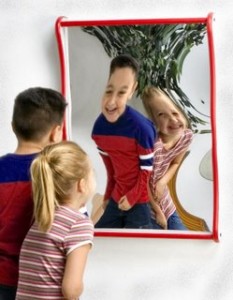
http://blog.lib.umn.edu/vanm0049/ psy1001section09spring2012/nature_vs_nurture2.jpg
Science reporting about a few of my favorite subjects: play, affect, and where it all comes from. New Scientist consultant Bob Holmes and co-author Kate Douglas take on the former, while Rachael E. Jack, et. al. take on the latter.
Human nature: Being playful
· 23 April 2012 by Bob Holmes and Kate Douglas
· Magazine issue 2861.
http://www.newscientist.com/article/mg21428610.300-human-nature-being-playful.html
Humans are not nature’s only funsters. All mammals play, as do some birds and a few other animals. But no other species pursues such a wide variety of entertainment or spends so much time enjoying themselves. The list of universals includes such diverse extracurricular pleasures as sports, music, games, joking, hospitality, hairdressing, dancing, art and tickling. What sets us apart is the fact that we play with objects and with language, says Clive Wynne at the University of Florida, Gainesville. We can also go beyond the literal. “What revolutionises human play is imagination,” says Francis Steen at the University of California, Los Angeles.
“We’re a playful species,” says primatologist Frans de Waal at Emory University in Atlanta, Georgia, and we retain our juvenile sense of fun right into adulthood. The only other primate to do that is the bonobo, perhaps as a result of its relaxed social environment. Human society is also relatively relaxed, de Waal notes, because we have moral codes and laws that promote stability. Crucially for the entertainment industry, we will also happily congregate with unrelated individuals, a situation that would leave both chimps and bonobos tearing strips off each other. Then there’s the simple matter of leisure time. In the wild, adult chimps spend around 8 hours a day foraging. Given more free time, they might play more. De Waal points out that captive apes enjoy computer games and watching TV, favouring scenes of sex and violence, but also appreciating slapstick humour.
But is it just opportunity that allows us to indulge our playful side, or do we actually need more entertainment than other animals? Play isn’t simply for fun, notes Marc Bekoff at the University of Colorado, Boulder. He identifies four primary purposes – physical development, cognitive development (“eye/paw coordination” as he calls it), social development and training for the unexpected. Playing is an evolutionary adaptation for learning, agrees Steen. Mammals are born inept but can adapt – playing helps us do that. Noting that human social and physical environments are particularly complex, he sees playing as a sort of simulator that allows us to imagine and try out different scenarios with little risk. “In play we are most fully human,” he says.
Bekoff believes social development is the most important purpose of play for humans, not least because it underpins morality. “Young children will not become properly socialised without it,” he says. For Robin Dunbar at the University of Oxford, playfulness is a mainstay of social cohesion. “Play often involves laughter, which is a very good bonding mechanism,” he says. And physical play – especially coordinated team sports – produces feel-good endorphins (Biology Letters, DOI: 10.1098/rsbl.2009.0670). In addition, sports provide a release for competitive urges, says de Waal. “If people watch others playing, that actually improves their own skills,” adds Steen. Even entertainment for sheer pleasure has benefits. “It’s fun, so it’s really good for mental health,” says Bekoff.
————————
Facial Expressions: As Much Nurture As Nature?
· April 19, 2012, 11:32 AM ET
· http://blogs.wsj.com/ideas-market/2012/04/19/facial-expressions-as-much-nurture-as-nature/
A new study suggests that East Asians perceive emotion in faces differently from Westerners, casting doubt on the thesis — proposed by Darwin and widely accepted in psychology today — that human facial expressions are largely universal.
Fifteen white European students and fifteen East Asians (young Chinese men and women recently arrived in Europe) were each asked to evaluate nearly 5,000 randomly generated expressions presented by way of 3D computer animation. Half the faces examined were “Western Caucasian,” half East Asian. (While the expressions were randomly generated, they were “natural,” adhering to rules governing how muscles interact.)
Fifteen white European students and 15 East Asians each rated nearly 5,000 randomly generated facial expressions, presented by way of 3-D computer animation; they chose one of six emotions — happiness, surprise, fear, disgust, anger, or sadness (or “don’t know”)—and rated the intensity. Those six emotions have long been thought to be the basic building blocks of human facial communication.
While the Europeans reacted with relative uniformity to the six categories, seemingly confirming their importance as discrete groups, the East Asian students showed far more disagreement, especially where surprise, fear, disgust, and anger were concerned. Reactions to these categories displayed substantial overlap, suggesting that they are not fundamental to the Asian way of “reading” faces. In contrast, muscle movements signifying happiness and sadness were robustly cross-cultural.
Another notable distinction was that East Asians were more likely to interpret early movement of the eyes as early indicators of strong emotion. Anecdotal confirmation for the importance of the eyes to East Asians comes in the form of emoticons: They type happy as ^ . ^ rather than :), and angry as >.<
It is possible, the researchers said, although the thesis was not tested in this study, that there are discrete “Asian” facial expressions that might elude Westerners — ones signifying shame, pride, and guilt, for instance.
The big picture, however, the authors say, is that the data re-open “unique nature-nuture debate across broad fields from evolutionary psychology and social neuroscience to social networking via digital avatars.”
Source: “Facial Expressions of Emotion are Not Culturally Universal,” Rachael E. Jack, Oliver G.B. Garrod, Hui Yu, Roberto Caldara and Philippe G. Schyns, PNAS (April 16 online)
Edited by James L. McClelland, Stanford University, Stanford, CA, and approved March 19, 2012 (received for review January 5, 2012)
Since Darwin’s seminal works, the universality of facial expressions of emotion has remained one of the longest standing debates in the biological and social sciences. Briefly stated, the universality hypothesis claims that all humans communicate six basic internal emotional states (happy, surprise, fear, disgust, anger, and sad) using the same facial movements by virtue of their biological and evolutionary origins [Susskind JM, et al. (2008) Nat Neurosci 11:843–850]. Here, we refute this assumed universality. Using a unique computer graphics platform that combines generative grammars [Chomsky N (1965) MIT Press, Cambridge, MA] with visual perception, we accessed the mind’s eye of 30 Western and Eastern culture individuals and reconstructed their mental representations of the six basic facial expressions of emotion. Cross-cultural comparisons of the mental representations challenge universality on two separate counts. First, whereas Westerners represent each of the six basic emotions with a distinct set of facial movements common to the group, Easterners do not. Second, Easterners represent emotional intensity with distinctive dynamic eye activity. By refuting the long-standing universality hypothesis, our data highlight the powerful influence of culture on shaping basic behaviors once considered biologically hardwired. Consequently, our data open a unique nature–nurture debate across broad fields from evolutionary psychology and social neuroscience to social networking via digital avatars.




